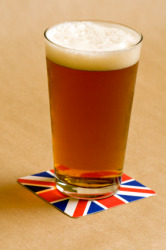NOTE: In the 2015 BJCP Style Guidelines, the old style 8C Extra Special Bitter has been reclassified and the name has been refined. It is now Style 11C Strong Bitter in Category 11 British Bitter which grew out of English pale ales as a draught product in the late 1800s.
“The use of crystal malts in bitters became more widespread after WWI. Traditionally served very fresh under no pressure (gravity or hand pump only) at cellar temperatures (i.e., “real ale”). Most bottled or kegged versions of UK-produced bitters are often higher-alcohol and more highly carbonated versions of cask products produced for export, and have a different character and balance than their draught counterparts in Britain (often being sweeter and less hoppy than the cask versions).
These guidelines reflect the “real ale” version of the style, not the export formulations of commercial products.
Several regional variations of bitter exist, ranging from darker, sweeter versions served with nearly no head to brighter, hoppier, paler versions with large foam stands, and everything in between.
Judges should not over-emphasize the caramel component of these styles. Exported bitters can be oxidized, which increases caramel-like flavors (as well as more negative flavors). Do not assume that oxidation-derived flavors are traditional or required for the style.”

Extra Special Bitter / Strong Bitter Description
Extra Special Bitters or Strong Bitters can be thought of as a bigger version of a Best Bitter. The naming convention is confusing for us Americans. Normally you would think that an Extra Special Bitter or Strong Bitter would be the high end product in a brewery’s line-up of beers but this is not the case.
The Best Bitter are traditionally considered a brewery’s finest product. In England, beer is sold by strength, so the ESB or Strong Bitter is essentially a more aggressive (but better balanced) beer.
We are not talking America here, so one should not think of the extreme characteristics of some American beers. The beer is not at all overpowering in alcohol or hop bitterness and although the color range is similar to the Best Bitter, these beers tend to fall on the darker end of the SRM scale.
The malt profile for an Extra Special Bitter or Strong Bitter will be bigger than a Best Bitter and you will often find more toasty and fruity notes in these beers.
Despite the name, Extra Special Bitter or Strong Bitter, they are not really over-the-top bitter like American beers can be. If there is one key to an ESB, it’s balance.
As with many beer names, some are exclusive to a particular brand. The designation of “ESB” is unique to the Fuller’s brand. In the U.S., we have adopted the acronym of ESB to represent any malty, bitter, standard (American) strength English style ale (as if that doesn’t make figuring out what beer goes with what name more difficult).
One of the distinguishing characteristics of Extra Special Bitter or Strong Bitters is that they may have a lot of caramel malt sweetness and a complex toasty or biscuity character to the malt profile. The higher levels of hop bitterness tend to balance this sweetness and biscuity character out to make a balanced beer.
Comments from the BJCP 2008 Style Guidelines: “Stronger versions may overlap somewhat with old ales, although strong bitters will tend to be paler and more bitter. Fuller’s ESB is a unique beer with a very large, complex malt profile not found in other examples; most strong bitters are fruitier and hoppier. Judges should not judge all beers in this style as if they were Fuller’s ESB clones. Some modern English variants are brewed exclusively with pale malt and are known as golden or summer bitters. Most bottled or kegged versions of UK-produced bitters are higher-alcohol versions of their cask (draught) products produced specifically for export. The IBU levels are often not adjusted, so the versions available in the US often do not directly correspond to their style subcategories in Britain. English pale ales are generally considered a premium, export-strength pale, bitter beer that roughly approximates a strong bitter, although reformulated for bottling (including containing higher carbonation)”.
ESB Brewing Tips:
Brewing Tips:
Several factors are important when brewing this beer and it holds true for all the English pale ales. Number one is to use a yeast that does not attenuate completely and that will produce the fruity esters typical in this style of beer. About 70% is a good target attenuation to shoot for when looking for your yeast. Another important factor is the hopping. Although these beers can be somewhat bitter, they should not be as hoppy as American versions. The hops used should be of the English variety such as Fuggles or East Kent Goldings, although a combination of English and American hops are used by some breweries. There should not be a big “late-hop” character in this beer which might detract from the balance. These hops will provide the necessary bitterness and flavor while still maintaining the expected English characteristics.
References: Information for this page was adapted from the 2008 BJCP Style Guidelines, and Brewing Classic Styles, 80 Winning Recipes Anyone Can Brew, by Jamil Zainasheff and John J. Palmer.
To Purchasse MoreBeer.com’s Extra Special Bitter Beer Kit, Click Here
Return to English Pale Ale Beer Styles Page
